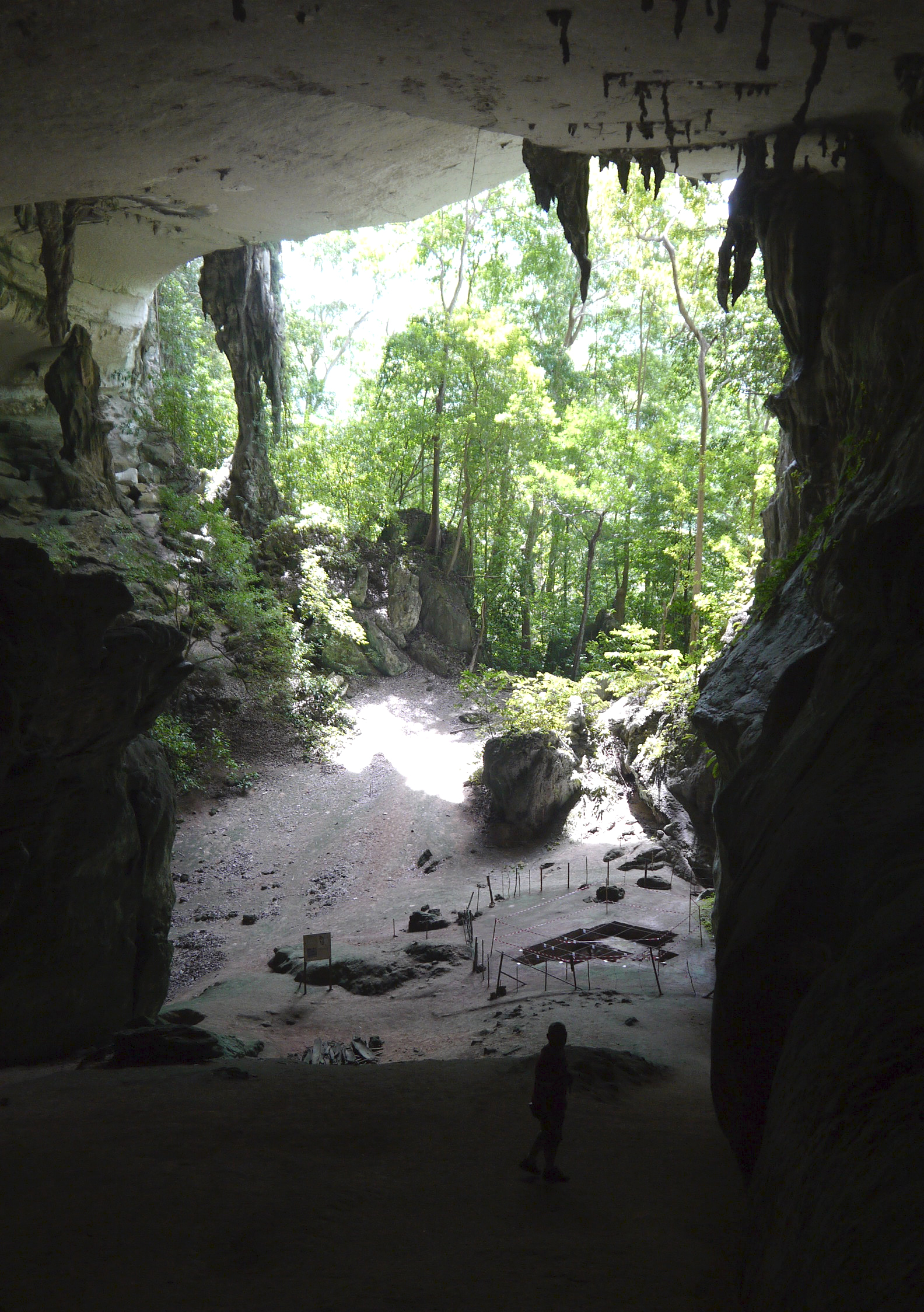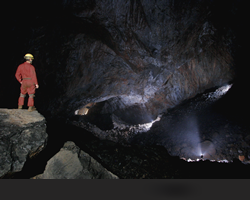|
Malayan Tailless Leaf-nosed Bat
The Malayan tailless leaf-nosed bat (''Coelops robinsoni'') is a species of bat in the family Hipposideridae. It is a very small bat which has long and soft fur. The fur coloration is brown to blackish on the dorsal surface and ashy on the ventral surface. It can be distinguished from the other roundleaf bats by its small size and the absence of the tail. It is listed as vulnerable by the IUCN (Heaney, 2008) Biology In Thailand, this species is known to form small colonies inhabiting caves and is considered a rare species (Lekagul & McNeely, 1977). In Peninsular Malaysia, the species has been recorded roosting in a cave and in the hollow buttress of a tree and shares its roosting site with '' Hipposideros ridleyi'' (Kingston ''et al.'' 2006; Francis, 2008). In the Philippines, this species was previously known as ''C. hirsutus'' and recorded only from Mindoro Island (Nowak, 1994; Wilson & Reeder, 2005). However, Hill (1972) suggested that ''C. hirsutus'' was a conspecific specie ... [...More Info...] [...Related Items...] OR: [Wikipedia] [Google] [Baidu] |
Hipposideridae
The Hipposideridae are a family of bats commonly known as the Old World leaf-nosed bats. While it has often been seen as a subfamily, Hipposiderinae, of the family Rhinolophidae, it is now more generally classified as its own family.Simmons, 2005, p. 365 Nevertheless, it is most closely related to Rhinolophidae within the suborder Yinpterochiroptera. Taxonomy The Hipposideridae contain 10 living genera and more than 70 species, mostly in the widespread genus ''Hipposideros''. In addition, several fossil genera are known; the oldest fossils attributed to the family are from the middle Eocene of Europe. In their 1997 ''Classification of Mammals'', Malcolm C. McKenna and Susan K. Bell proposed a division of Hipposideridae (called Rhinonycterinae in their work) into three tribes, one with two subtribes, but these tribes turned out to be non- monophyletic and have been abandoned. A different classification was proposed by Hand and Kirsch in 2003. In 2009, Petr Benda and Peter Vallo ... [...More Info...] [...Related Items...] OR: [Wikipedia] [Google] [Baidu] |
Hipposideros Ridleyi
Ridley's leaf-nosed bat, Ridley's roundleaf bat, or Singapore roundleaf horseshoe bat (''Hipposideros ridleyi'') is a species of bat in the family Hipposideridae. It is found in Brunei, Malaysia and Singapore. Its natural habitat is subtropical or tropical swamps. It is threatened by habitat loss. Taxonomy Ridley's leaf-nosed bat was described as a new species in 1911 by Herbert Christopher Robinson and C. Boden Kloss. The holotype had been collected by English botanist Henry Nicholas Ridley in the Singapore Botanic Gardens in 1911. Description Ridley's leaf-nosed bat has a forearm length of . Its nose-leaf is very large and dark, covering its muzzle. The nose-leaf lacks lateral leaflets (smaller projections to the side). Range and tatus It is found in Southeast Asia where it has been documented in Brunei, Malaysia, and Singapore. It is found at a range of elevations from above sea level. Its habitat is lowland old-growth forest. Possibly, its range also includes Indonesia. As ... [...More Info...] [...Related Items...] OR: [Wikipedia] [Google] [Baidu] |
Mindoro
Mindoro is the seventh largest and eighth-most populous island in the Philippines. With a total land area of 10,571 km2 ( 4,082 sq.mi ) and has a population of 1,408,454 as of 2020 census. It is located off the southwestern coast of Luzon and northeast of Palawan. Mindoro is divided into two provinces: Occidental Mindoro and Oriental Mindoro. San Jose, Occidental Mindoro, San Jose is the largest settlement on the island with a total population of 143,430 inhabitants as of 2015. The southern coast of Mindoro forms the northeastern extremum of the Sulu Sea. Mount Halcon is the highest point on the island, standing at above sea level located in Oriental Mindoro. Mount Baco is the island's second highest mountain with an elevation of , located in the province of Occidental Mindoro. Geography Mindoro is seventh (7th) largest island in the Philippines. It is divided by two provinces Occidental Mindoro and Oriental Mindoro. Mindoro Mountain Range is the largest and longest mou ... [...More Info...] [...Related Items...] OR: [Wikipedia] [Google] [Baidu] |
Sarawak
Sarawak (; ) is a States and federal territories of Malaysia, state of Malaysia. The largest among the 13 states, with an area almost equal to that of Peninsular Malaysia, Sarawak is located in northwest Borneo Island, and is bordered by the Malaysian state of Sabah to the northeast, Kalimantan (the Indonesian portion of Borneo) to the south, and Brunei in the north. The capital city, Kuching, is the largest city in Sarawak, the economic centre of the state, and the seat of the Sarawak state government. Other cities and towns in Sarawak include Miri, Malaysia, Miri, Sibu, and Bintulu. As of 2021, the population of Sarawak was estimated to be around 2.45 million. Sarawak has an equatorial climate with tropical rainforests and abundant animal and plant species. It has several prominent cave systems at Gunung Mulu National Park. Rajang River is the longest river in Malaysia; Bakun Dam, one of the largest dams in Southeast Asia, is located on one of its tributaries, the Balui River ... [...More Info...] [...Related Items...] OR: [Wikipedia] [Google] [Baidu] |
Bintulu
Bintulu is a coastal town on the island of Borneo in the central region of Sarawak, Malaysia. Bintulu is located 610 kilometres (380 mi) northeast of Kuching, 216 kilometres (134 mi) northeast of Sibu, and 200 kilometres (120 mi) southwest of Miri. With a population of 114,058 as of 2010, Bintulu is the capital of the Bintulu District of the Bintulu Division of Sarawak, Malaysia. The name of Bintulu was derived from the local native language "Mentu Ulau" (picking heads). Bintulu was a small fishing village when Rajah James Brooke acquired it in 1861. Brooke later built a fort there in 1862. In 1867, the first General Council meeting (now Sarawak State Legislative Assembly) was convened in Bintulu. It is the earliest state legislature system in Malaysia. The construction of the earliest airstrip in Bintulu began in 1934 but was halted in 1938 due to financial difficulties. During World War II, the airstrip was heavily bombed by Allied forces. The British later rebu ... [...More Info...] [...Related Items...] OR: [Wikipedia] [Google] [Baidu] |
Niah National Park
Niah National Park, located within Miri Division, Sarawak, Malaysia, is the site of the Niah Caves limestone cave and archeological site. History Alfred Russel Wallace lived for 8 months at Simunjan District with a mining engineer, Robert Coulson, who had explored what is now northern Sarawak for mineral ores. Coulson later wrote to Wallace about finding bones in a number of caves in Sarawak. On further enquiry, Wallace learned that one cave in question "was situated in the district between Sarawak and Bruni (Brunei), on a mountain some distance inland." In March 1864, Wallace favoured Coulson to explore the caves. However, later in May 1864, G. J. Ricketts, a British Consul to Sarawak was appointed to undertake the work. Ricketts did not remain in the post for long and subsequently Alfred Hart Everett was chosen to undertake the work. Everett surveyed 32 caves in three areas, including Niah/Subis (near Miri) and "Upper Sarawak Proper" (to the south of Kuching). In the 1950s ... [...More Info...] [...Related Items...] OR: [Wikipedia] [Google] [Baidu] |
Gunung Mulu National Park
The Gunung Mulu National Park is a national park in Miri Division, Sarawak, Malaysia. It is a UNESCO World Heritage Site that encompasses caves and karst formations in a mountainous equatorial rainforest setting. The park is famous for its caves and the expeditions that have been mounted to explore them and their surrounding rainforest, most notably the Royal Geographical Society Expedition of 1977–1978, which saw over 100 scientists in the field for 15 months. This initiated a series of over 20 expeditions now named the Mulu Caves Project. The national park is named after Mount Mulu, the second highest mountain in Sarawak. History The earliest reference to the Mulu caves was in 1858 when Spenser St. John (British Consul in Brunei) mentioned the "detached masses of limestone, much water-worn, with caverns and natural tunnels” in his book "Life in the Forests of the Far East". Spenser tried to ascend Mount Mulu later but failed due to limestone cliffs, dense forests, and s ... [...More Info...] [...Related Items...] OR: [Wikipedia] [Google] [Baidu] |
Gunong Benom
Mount Benum or Mount Benom ( ms, Gunung Benom) is a mountain in the state of Pahang in Malaysia. Its summit is above sea level. See also * List of Ultras of Southeast Asia * List of mountains in Malaysia * Jerantut * Raub District * Krau Wildlife Reserve * Tenasserim Hills References Further reading * A list of plant species collected was established by Henry Nicholas Ridley Henry Nicholas Ridley CMG (1911), MA (Oxon), FRS, FLS, F.R.H.S. (10 December 1855 – 24 October 1956) was an English botanist, geologist and naturalist who lived much of his life in Singapore. He was instrumental in promoting rubber trees i ... and is included at pp. 10–18. * Hill, J. E. 1972. The Gunong Benom Expedition 1967. 4. New records of Malayan bats, with taxonomic notes and the description of a new Pipistrellus. ''Bulletin British Museum (National History) Zoology'' 23 (3):28-29. External links "Gunung Benom, Malaysia" on Peakbagger"Gunung Benum" on Peakery Benum {{Pahang- ... [...More Info...] [...Related Items...] OR: [Wikipedia] [Google] [Baidu] |
Coelops
''Coelops'' is a genus of bat in the family Hipposideridae. It contains the following species: * East Asian tailless leaf-nosed bat (''Coelops frithii'') * Malayan tailless leaf-nosed bat The Malayan tailless leaf-nosed bat (''Coelops robinsoni'') is a species of bat in the family Hipposideridae. It is a very small bat which has long and soft fur. The fur coloration is brown to blackish on the dorsal surface and ashy on the ventra ... (''Coelops robinsoni'') References Bat genera Taxa named by Edward Blyth Taxonomy articles created by Polbot {{Hipposideridae-stub ... [...More Info...] [...Related Items...] OR: [Wikipedia] [Google] [Baidu] |
Mammals Described In 1903
Mammals () are a group of vertebrate animals constituting the class Mammalia (), characterized by the presence of mammary glands which in females produce milk for feeding (nursing) their young, a neocortex (a region of the brain), fur or hair, and three middle ear bones. These characteristics distinguish them from reptiles (including birds) from which they diverged in the Carboniferous, over 300 million years ago. Around 6,400 extant species of mammals have been described divided into 29 orders. The largest orders, in terms of number of species, are the rodents, bats, and Eulipotyphla (hedgehogs, moles, shrews, and others). The next three are the Primates (including humans, apes, monkeys, and others), the Artiodactyla ( cetaceans and even-toed ungulates), and the Carnivora (cats, dogs, seals, and others). In terms of cladistics, which reflects evolutionary history, mammals are the only living members of the Synapsida (synapsids); this clade, together wi ... [...More Info...] [...Related Items...] OR: [Wikipedia] [Google] [Baidu] |
Taxa Named By J
In biology, a taxon (back-formation from ''taxonomy''; plural taxa) is a group of one or more populations of an organism or organisms seen by taxonomists to form a unit. Although neither is required, a taxon is usually known by a particular name and given a particular ranking, especially if and when it is accepted or becomes established. It is very common, however, for taxonomists to remain at odds over what belongs to a taxon and the criteria used for inclusion. If a taxon is given a formal scientific name, its use is then governed by one of the nomenclature codes specifying which scientific name is correct for a particular grouping. Initial attempts at classifying and ordering organisms (plants and animals) were set forth in Carl Linnaeus's system in ''Systema Naturae'', 10th edition (1758), as well as an unpublished work by Bernard and Antoine Laurent de Jussieu. The idea of a unit-based system of biological classification was first made widely available in 1805 in the intro ... [...More Info...] [...Related Items...] OR: [Wikipedia] [Google] [Baidu] |

_(14772309735).jpg)



